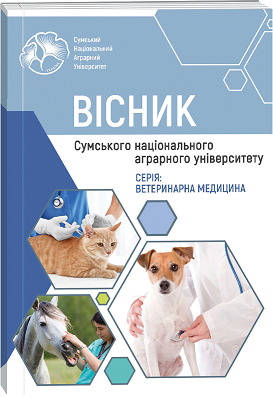STUDY OF THE PREVALENCE AND METHODS OF DETECTION OF EIMERIOSIS AMONG RABBITS DEPENDING ON DIFFERENT METHODS OF KEEPING
Abstract
One of the key difficulties in the process of raising rabbits is eimeriosis, regardless of the methods of keeping them. This disease affects animals of all age groups, leading to a decrease in weight gain, deterioration of the efficiency of assimilation of feed, increased morbidity. The purpose of the study was to determine the prevalence and methods of detection of eimeriosis among rabbits, depending on different methods of keeping, with the aim of improving strategies for combating this disease and improving quarantine methods. During the period from 2019 to 2021, research was conducted in farms with different power levels in four regions: Zaporizhzhya, Donetsk, Kharkiv and Sumy. In total, 20 farms where rabbits of different breeds were kept were surveyed. In farms and private rabbit farms, E. intestinalis, E. magna, E. media, E. piriforms, E. perforans, E. irresidua were isolated. It was proved that in the winter period the level of oocysts was from 12±1.2 to 34±2.4 in p.z. microscope In the summer period, the level of infestation decreased and ranged from a maximum of 15±1.2 (EI = 19%) to a minimum of 5±2.0 (EI = 6%). The study confirmed that in conditions of keeping in metal cages in farms, with compliance with sanitary and hygienic norms and regular disinfection of premises, the level of infestation was from 15% to 42% in the winter period and from 6% to 19% in the summer period. In an analysis of data obtained from private farms where rabbits are kept in wooden cages with deep bedding, it was found that the infestation rate was between 56% and 100% during the cold period and between 29% and 70% during the warm period. The use of metal cages for keeping rabbits in compliance with sanitary and hygienic requirements and timely disinfection helps to reduce the prevalence of parasitic infections.
References
2. Athanasiou, L. V., Tsokana, C. N., Doukas, D., Kantere, M. C., Katsoulos, P. D., Papakonstantinou, G. I., Katsogiannou, E. G., & Dedousi, A. (2023). Hepatic Coccidiosis in Wild Rabbits in Greece: Parasite Detection on Liver Imprints and the Associated Biochemical Profile. Veterinary sciences, 10(4), 248. https://doi.org/10.3390/vetsci10040248
3. Dawod, A., Fathalla, S., El-Seedi, H. R., Hammad, M. A., Osman, N., Abosheriba, N., Anis, A., Shehata, A. A., & Elkhatam, A. (2022). Efficacy of Ficus sycomorus (Sycamore Fig) Extract on Intestinal Coccidiosis in Experimentally Infected Rabbits. Life (Basel, Switzerland), 12(6), 917. https://doi.org/10.3390/life12060917
4. El-Ashram, S. A., Aboelhadid, S. M., Abdel-Kafy, E. M., Hashem, S. A., Mahrous, L. N., Farghly, E. M., Moawad, U. K., & Kamel, A. A. (2019). Prophylactic and Therapeutic Efficacy of Prebiotic Supplementation against Intestinal Coccidiosis in Rabbits. Animals : an open access journal from MDPI, 9(11), 965. https://doi.org/10.3390/ani9110965
5. El-Shall, N. A., Abd El-Hack, M. E., Albaqami, N. M., Khafaga, A. F., Taha, A. E., Swelum, A. A., El-Saadony, M. T., Salem, H. M., El-Tahan, A. M., AbuQamar, S. F., El-Tarabily, K. A., & Elbestawy, A. R. (2022). Phytochemical control of poultry coccidiosis: a review. Poultry science, 101(1), 101542. https://doi.org/10.1016/j.psj.2021.101542
6. Ogolla, K. O., Gathumbi, P. K., Waruiru, R. M., Okumu, P. O., Chebet, J., & Kitala, P. M. (2018). Efficacy of Sulphachloropyrazine, Amprolium Hydrochloride, Trimethoprim-Sulphamethoxazole, and Diclazuril against Experimental and Natural Rabbit Coccidiosis. Journal of veterinary medicine, 2018, 5402469. https://doi.org/10.1155/2018/5402469
7. Sadhukhan, S.K. (2022). Prevention and Control of Parasitic Zoonoses. In: Parija, S.C., Chaudhury, A. (eds) Textbook of Parasitic Zoonoses. Microbial Zoonoses. Springer, Singapore. 83-90. https://doi.org/10.1007/978-981-16-7204-0_9
8. Saeed, Z., & Alkheraije, K. A. (2023). Botanicals: A promising approach for controlling cecal coccidiosis in poultry. Frontiers in veterinary science, 10, 1157633. https://doi.org/10.3389/fvets.2023.1157633
9. Sierra-Galicia, M. I., Rodríguez-de Lara, R., Orzuna-Orzuna, J. F., Lara-Bueno, A., García-Muñiz, J. G., Fallas-López, M., & Hernández-García, P. A. (2022). Supplying Bee Pollen and Propolis to Growing Rabbits: Effects on Growth Performance, Blood Metabolites, and Meat Quality. Life (Basel, Switzerland), 12(12), 1987. https://doi.org/10.3390/life12121987
10. Silva, S. M., Ferreira, C., Paupério, J., Silva, R. M., Alves, P. C., & Lemos, A. (2015). Coccidiosis in European rabbit (Oryctolagus cuniculus algirus) populations in the Iberian Peninsula. Acta parasitologica, 60(2), 350–355. https://doi. org/10.1515/ap-2015-0049
11. Sinha, S., Kaur, U., Sehgal, R. (2022). Diagnosis of Parasitic Zoonoses. In: Parija, S.C., Chaudhury, A. (eds) Textbook of Parasitic Zoonoses. Microbial Zoonoses. Springer, Singapore. 59-74. https://doi.org/10.1007/978-981-16-7204-0_7
12. Sioutas, G., Evangelou, K., Vlachavas, A., & Papadopoulos, E. (2021). Deaths Due to Mixed Infections with Passalurus ambiguus, Eimeria spp. and Cyniclomyces guttulatus in an Industrial Rabbit Farm in Greece. Pathogens (Basel, Switzerland), 10(6), 756. https://doi.org/10.3390/pathogens10060756
13. Thompson Burdine, J., Thorne, S., & Sandhu, G. (2021). Interpretive description: A flexible qualitative methodology for medical education research. Medical education, 55(3), 336–343. https://doi.org/10.1111/medu.14380
14. Xiao, J., Zheng, R., Bai, X., Pu, J., Chen, H., Gu, X., Xie, Y., He, R., Xu, J., Jing, B., Peng, X., & Yang, G. (2022). Preliminary evaluation of the protective effects of recombinant AMA1 and IMP1 against Eimeria stiedae infection in rabbits. Parasites & vectors, 15(1), 400. https://doi.org/10.1186/s13071-022-05492-4
15. Xie, Y., Xiao, J., Zhou, X., Gu, X., He, R., Xu, J., Jing, B., Peng, X., & Yang, G. (2021). Global transcriptome landscape of the rabbit protozoan parasite Eimeria stiedae. Parasites & vectors, 14(1), 308. https://doi.org/10.1186/ s13071-021-04811-5

 ISSN
ISSN  ISSN
ISSN 



